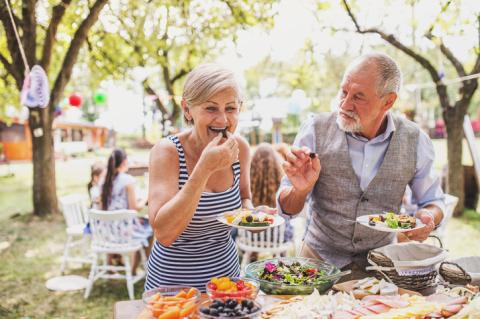Food Safety in the Great Outdoors
Food always tastes better outside, doesn’t it? But food safety guidelines apply whether you’re in your own kitchen or cooking over a roaring fire in the wilderness. Prepare and store foods safely, especially if senior loved ones are on the jaunt with you.
The bacteria, viruses, parasites and other pathogens that cause foodborne illnesses can make us sick for a few days, or cause a much more serious illness. These infections are especially dangerous for older adults, whose bodies are less able to fight off germs. The Centers for Disease Control and Prevention (CDC) says that many of the 3,000 fatal cases of food poisoning in the U.S. each year occur in people older than 65.
Here are some common questions about a safe outdoor repast, with answers from the U.S. Department of Agriculture Food Safety and Inspection Service (FSIS):
Q: How can I keep foods cold enough to prevent the growth of bacteria?
A: Unless you’re eating it right away, all perishable foods should be packed in a cooler until eaten or cooked. The FSIS offers these cooler safety tips:
- A block of ice keeps longer than ice cubes. Or make giant ice cubes using clean, empty milk cartons in your freezer.
- Pack foods in reverse order that you’ll use them—the first ones on top. The exception is raw meat or poultry, which should be under other all foods to keep meat juices from dripping on them.
- If you can, bring two coolers—one for perishable foods such as meat, and another, for drinks and snacks, that you’ll likely be opening more often.
- Keep the cooler closed, out of the sun, and insulated with a blanket or tarp. Remember that the melted ice may have picked up bacteria.
Q: Am I following safe outdoor cooking practices?
A: Whether you’re using a camp stove, a grill or a fire, foods should be cooked to a safe temperature. The FSIS suggests bringing a food thermometer, just to be safe. Ground meat in particular can be contaminated with bacteria, so it’s important that burgers are cooked to a safe temperature (160°), with no visible pink. Poultry should be cooked to 165° and fish to 145°.
Q: What if I can’t keep foods cold?
If your outing lasts for more than a day, or you can’t bring a cooler, pack nonperishable foods. The FSIS suggest a menu that includes peanut butter, canned tuna or ham, dried soups and noodles, dried fruits, nuts, beef jerky and powdered drinks.
Q: What about water?
A: If you’re not sure that clean water will be available at your destination, it’s best to bring as much bottled or tap water as you will need, especially for seniors in your group. Remember that dangerous parasites can live in lake, river and stream water, so if you plan to drink water from those sources on a hike, treat it by boiling for one minute (longer at higher altitudes) or treating it with purification tablets and a water filter.
Q: What if fishing is on the agenda?
A: Learn ahead of time if it’s safe to consume fish or other seafood from the place you’re going. If you’re bringing fish home, scale, gut and clean them promptly. Wrap in waterproof plastic and store on ice. Keep them cold and consume or freeze them within a day or two.
By following these food safety practices, you’ll lower the risk that your camping trip will be followed by a couple of days camping out in the bathroom … or a trip to the hospital.
